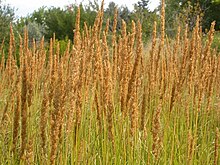Melica argyrea is a species of grass found in Argentina, Brazil, and Uruguay.
Melica bonariensis is a species of grass endemic to Argentina where it can be found in such provinces as Buenos Aires, La Pampa, and Rio Negro.
Melica dendroides is a grass species in the family Poaceae that is endemic to southern part of Africa.
Melica commersonii is a species of grass endemic to Chile.
Melica hitchcockii is a species of grass that can be found in Waterton Lakes Park of Alberta, Canada where it grows in a forest about 0.5 miles east of Cameron Lake at the elevation of 5,600 feet (1,700 m).
Melica hyalina is a species of grass found in Brazil and southern South America.
Melica glabrescens is a species of grass found in Buenos Aires and Río Negro, Argentina.
Melica decipiens is a species of grass that can be found in the mountains of Cordoba and San Luis provinces of Argentina.
Melica paulsenii is a species of grass endemic to Chile where it grows along the coastal cordillera at 50–700 metres (160–2,300 ft) above sea level.
Melica mollis is a species of grass endemic to Chile where it grows in rock crevices at 340 metres (1,120 ft) above sea level.
Melica rigida is a species of grass found in Argentina, Brazil, and Uruguay.
Melica patagonica is a species of grass that is endemic to South America.
Melica parodiana is a species of grass found in Buenos Aires, Argentina and Uruguay.
Melica riograndensis is a species of grass in the family Poaceae that is endemic to Brazil.

Calamagrostis varia is a species of flowering plant from the family Poaceae which is native to Europe.

Agrostis vinealis is a species of grass known by the common names brown bentgrass and brown bent, which can be found from Russia to Mongolia, China, Pakistan, India and Alaska. It was introduced to Greenland and South Georgia and the South Sandwich Islands.

Agrostis humilis is a species of grass known by the common names of mountain bent grass and alpine bentgrass, which can be found in Western United States and Canada.

Calamagrostis villosa is a species of flowering plant from the family Poaceae which is native to Europe.
Festuca abyssinica is a species of grass which is endemic to Africa.
Agrostis thurberiana is a species of grass that is native to northwest and southwest United States and Canada.




